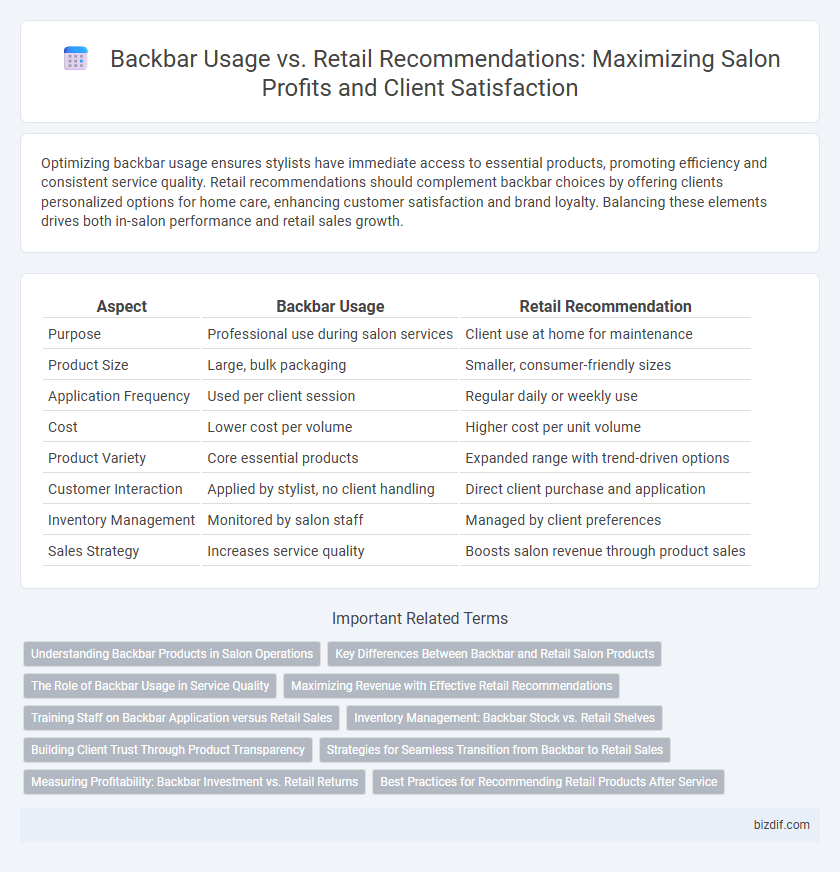Optimizing backbar usage ensures stylists have immediate access to essential products, promoting efficiency and consistent service quality. Retail recommendations should complement backbar choices by offering clients personalized options for home care, enhancing customer satisfaction and brand loyalty. Balancing these elements drives both in-salon performance and retail sales growth.
Table of Comparison
| Aspect | Backbar Usage | Retail Recommendation |
|---|---|---|
| Purpose | Professional use during salon services | Client use at home for maintenance |
| Product Size | Large, bulk packaging | Smaller, consumer-friendly sizes |
| Application Frequency | Used per client session | Regular daily or weekly use |
| Cost | Lower cost per volume | Higher cost per unit volume |
| Product Variety | Core essential products | Expanded range with trend-driven options |
| Customer Interaction | Applied by stylist, no client handling | Direct client purchase and application |
| Inventory Management | Monitored by salon staff | Managed by client preferences |
| Sales Strategy | Increases service quality | Boosts salon revenue through product sales |
Understanding Backbar Products in Salon Operations
Backbar products in salon operations play a crucial role in delivering professional services and ensuring client satisfaction through consistent quality and effective results. Proper understanding of backbar usage helps optimize inventory management and reduces wastage by accurately predicting product consumption during treatments. Retail recommendations should complement backbar selections to encourage clients to maintain salon results at home while boosting overall salon revenue.
Key Differences Between Backbar and Retail Salon Products
Backbar products in salons are designed for professional use, often containing higher concentrations of active ingredients to deliver more effective and immediate results during treatments. Retail salon products are formulated for at-home use, emphasizing ease of application, safety, and longer shelf life while maintaining visible benefits. Key differences include formulation strength, packaging size, and pricing strategy, aligning backbar products with expert application and retail products with consumer convenience.
The Role of Backbar Usage in Service Quality
Backbar usage plays a crucial role in maintaining high service quality by ensuring that professionals have immediate access to premium products tailored for effective treatments. Consistent use of backbar products allows stylists to deliver uniform results, reinforcing client trust and satisfaction. Strategically balancing backbar consumption with retail recommendations encourages clients to continue optimal hair care at home, extending the benefits of salon services.
Maximizing Revenue with Effective Retail Recommendations
Maximizing salon revenue hinges on strategic backbar usage paired with effective retail recommendations that align with client needs and hair care routines. Employing professional-grade backbar products during treatments builds trust and showcases product efficacy, which naturally encourages clients to purchase retail versions for home use. Training staff to recommend complementary retail products based on observed client hair conditions and treatment outcomes directly boosts retail sales and enhances overall profitability.
Training Staff on Backbar Application versus Retail Sales
Effective salon management emphasizes comprehensive staff training on backbar product application to ensure professional and consistent client results, thereby enhancing service quality. Prioritizing hands-on education over purely retail sales techniques builds client trust and encourages repeat visits, which indirectly boosts product demand. Well-trained staff using backbar items confidently can naturally recommend retail products, creating a seamless connection between in-salon services and at-home care.
Inventory Management: Backbar Stock vs. Retail Shelves
Effective inventory management balances backbar stock and retail shelves to minimize product waste and maximize sales. Maintaining adequate backbar supplies ensures stylists have immediate access to essential products without overstocking, while optimized retail shelf inventory attracts customers and encourages purchases. Strategic synchronization between backbar usage rates and retail displays improves overall salon profitability by reducing excess inventory and enhancing client satisfaction.
Building Client Trust Through Product Transparency
Clear backbar usage guidelines paired with transparent retail recommendations empower clients to make informed decisions about salon products. Displaying product ingredients and benefits directly in the salon fosters trust and demonstrates commitment to client well-being. Prioritizing honesty and education in product presentation strengthens brand loyalty and encourages repeat purchases.
Strategies for Seamless Transition from Backbar to Retail Sales
Implement a targeted training program for staff to confidently recommend retail products that complement backbar treatments, enhancing client trust and purchase intent. Position retail items strategically near service stations to encourage spontaneous buying while reinforcing the link between professional use and at-home care. Utilize personalized consultation during appointments to tailor product recommendations, facilitating a smooth transition from backbar experiences to retail sales.
Measuring Profitability: Backbar Investment vs. Retail Returns
Evaluating backbar usage against retail recommendations requires analyzing cost efficiency and profit margins, where backbar products represent a sunk investment and retail sales generate direct revenue. Tracking product depletion rates in the backbar alongside retail sales data provides insights into how effectively salon inventory translates into customer purchases and overall profitability. Optimizing this balance enhances inventory turnover and maximizes return on investment by aligning in-salon product usage with consumer buying behavior.
Best Practices for Recommending Retail Products After Service
Effective backbar usage ensures clients experience professional-grade products during their service, establishing trust and familiarizing them with the benefits. Recommending retail products immediately after the service capitalizes on this trust, highlighting specific items used that address the client's unique hair or skin needs. Best practices include personalized suggestions based on observed client concerns and offering educational insights to empower informed purchase decisions.
Backbar Usage vs Retail Recommendation Infographic

 bizdif.com
bizdif.com